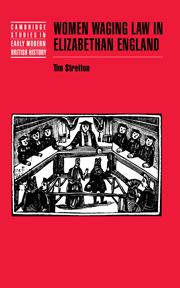Book contents
- Frontmatter
- Contents
- Lists of maps and figures
- List of tables
- Preface
- Notes on the text
- Abbreviations
- 1 Introduction
- 2 Women, legal rights and law courts
- 3 Female litigants and the culture of litigation
- 4 The Court of Requests
- 5 Unmarried women and widows
- 6 Married women in Requests
- 7 Freebench, custom and equity
- 8 Pleading strategies in Requests
- 9 Women waging law
- Glossary
- Bibliography
- Index
- Cambridge Studies in Early Modern British History
9 - Women waging law
Published online by Cambridge University Press: 11 November 2009
- Frontmatter
- Contents
- Lists of maps and figures
- List of tables
- Preface
- Notes on the text
- Abbreviations
- 1 Introduction
- 2 Women, legal rights and law courts
- 3 Female litigants and the culture of litigation
- 4 The Court of Requests
- 5 Unmarried women and widows
- 6 Married women in Requests
- 7 Freebench, custom and equity
- 8 Pleading strategies in Requests
- 9 Women waging law
- Glossary
- Bibliography
- Index
- Cambridge Studies in Early Modern British History
Summary
Women have no voyse in Parliament, They make no Lawes, they consent to none, they abrogate none. All of them are understood either married or to bee married and their desires [are] subject to their husband. I know no remedy though some women can shift it well enough.
T.E. The Lawes Resolutions of Womens Rights (1632)In The Patriarch's Wife, Margaret Ezell posed the rhetorical question: ‘was seventeenth-century England a society of submissive, deferential, opinionless females whose quietude was ensured by their ignorance and a hostile legal system?’ If we broaden her question to include the sixteenth century, the answer is clearly no. As countless examples in the foregoing chapters confirm, the central courts at Westminster regularly processed cases involving knowledgeable women who were neither submissive nor deferential. The legal system was certainly hostile in the sense that crown, judiciary and parliament each accorded women fewer rights than men, but these bodies never denied women rights altogether, and female litigants went to court in their thousands.
Women's relationship with the law was far from ideal, but it was not as uniformly bleak as some commentators have assumed. A variety of separate courts operated side by side in England, applying principles of equity or administering common law, ecclesiastical law or custom. Even the most male-centred of these jurisdictions provided women with distinctive rights and assistance, as well as burdening them with distinctive obligations and restrictions on their freedoms.
- Type
- Chapter
- Information
- Women Waging Law in Elizabethan England , pp. 216 - 240Publisher: Cambridge University PressPrint publication year: 1998

